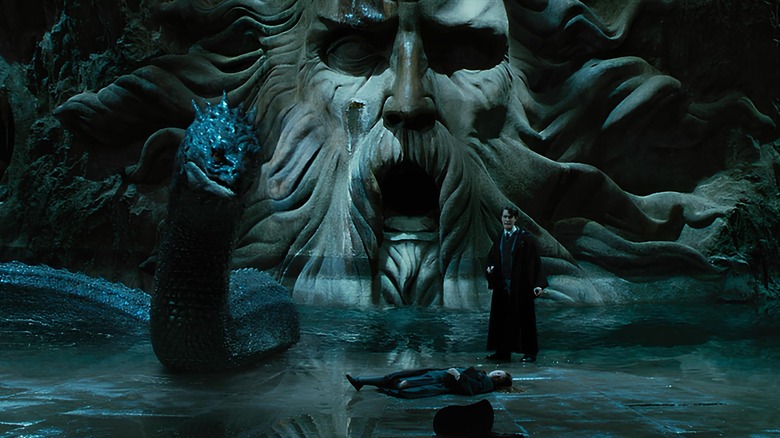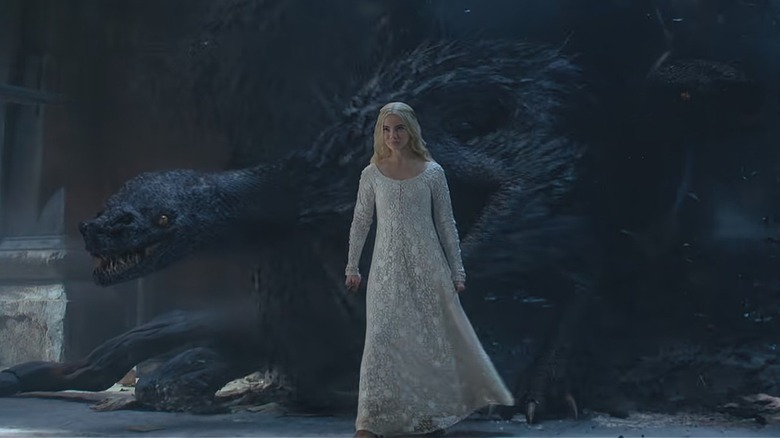Harry Potter's Basilisk Has A Surprising Origin Story
In the wizarding world of J. K. Rowling's "Harry Potter" franchise, the basilisk is a mighty serpent whose very gaze can kill. As the Boy Who Lived discovers in "Harry Potter and the Chamber of Secrets," even indirect eye contact with a basilisk can be dangerous as it inflicts total petrification. Magical murder eyes aside, basilisks also carry a fatally potent venom in their fangs, for which there is almost no cure.
In short, the chance of encountering one and living to share the tale is minute at best, so it's kind of funny that these mythological monstrosities are hatched from a chicken's egg incubated by a toad. All it takes to create one of the most dangerous creatures known to wizard-kind is to shove a chicken egg beneath a toad.
According to the histories provided by Rowling herself, a dark wizard named Herpo the Foul is the first on record to ever breed a basilisk. Good ol' Herp' is also on record as the first wizard to ever create a Horcrux because why stop at one wretched act when there are so many atrocities to commit, right? No exact time frame is given as to when the character first bred the King of Serpents. However, he is chronicled as being from Ancient Greece, and the practice of breeding basilisks wasn't banned by the Department for Regulation and Control of Magical Creatures until Medieval Times.
Using very rough ballpark figures, Ancient Greece covers 900 BCE to 600 CE, and Medieval Times covers 450 CE to 1450 CE, so it's possible that the Ministry of Magic response time was immediate ... but it's also possible that basilisk breeding was unregulated for several hundred years.
Basilisks differ greatly across fantasy franchises
J. K. Rowling's basilisk is terrifying and gargantuan and almost wholly unique to her fiction. Like most iterations of the mythical reptile, her basilisk features deadly eyes, poisonous fangs, and is born from a chicken's egg incubated beneath a toad. That said, the wider understanding of basilisks allows for them to be bred beneath a serpent, as well. Speaking of serpents, a basilisk almost never looks like what Rowling created. Where her beast is a giant snake, most depictions of basilisks are far smaller and more iguana-like. Basilisks often feature a mixture of scales and feathery plumage, along with a varying number of legs or wings, depending on the region.
In Netflix's live-action adaptation of Andrzej Sapkowski's "The Witcher," the basilisk that appears in Season 2, Episode 8, "Family," is a raptor-like beast. In CD Projekt Red's "The Witcher III: Wild Hunt," basilisks are more dragon-like, both in size and shape, although they still feature notable visual elements that harken to their chicken egg origins. Leaving "The Witcher" behind, in the Naturalis Historia, the Roman version of the basilisk is the approximate size and shape of a regular garden snake.
Another aspect that Rowling invented from whole cloth is the basilisk's fear of spiders. Certain iterations of the beast are notably afraid of the scent of weasels but nowhere else are spiders ever mentioned. We like to think that Rowling changed this particular factoid so that she could avoid writing a scene where Harry accidentally defeats the basilisk by wielding an unconscious Ginny like some high-level warding spell.

